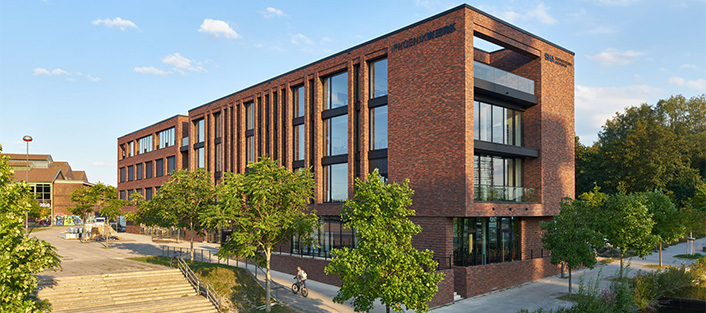
SHA Scheffler Helbich Architekten GmbH
Phoenixplatz 3
44263 Dortmund
The first construction phase of Borussia Dortmund’s new training center with the first four pitches and the first building was completed just in time for the World Cup in 2006. During the World Cup, Ronaldinho, Rosicky and Raul had state-of-the-art training conditions at their disposal. Following the World Cup, BVB’s professionals, amateurs and youngsters then moved under the same roof at the new training center. In the knowledge that youth is an essential asset of a soccer club, all training-relevant and training-related facilities were brought together under one roof in order to achieve synergies.
At the same time, the idea grew of creating a second important point of identification for players, fans and the media alongside the stadium, similar to the “Geißbockheim” in Cologne or the “Säbener Straße” in Munich. As a shared address, BVB welcomes all guests under one roof. On the left, the athletes enter the main building with changing areas, sports medicine center and strength training area. On the right, media representatives enter rooms for the press conference with expansion options for a small fan store and fan catering, while access to the training ground opens up in the middle. The heart of the complex is the joint “Borussen Boulevard”. As the backbone, it connects the first four squares and the main building in the first construction phase as well as all other squares in the future. Raised by three steps, it not only stages the center of the park. In future, it will offer fans and the media the opportunity to observe and follow the training of their professionals on a large joint action area.
The exterior design of the building is determined by the regular grid of roof columns, which unites the buildings with their different functions and structures the façade. It is a conscious decision for a relief with light and shadow. Under the roof, the larch wood slatted façade creates a calm image appropriate to the training center. The slats are grouped together in bays across both storeys in a galvanized steel frame. All visible wooden elements are rough sawn and varnished silver-grey before installation. The onset of weathering and the associated gray patina is thus visually anticipated and guarantees the absence of major color variations on differently weathered façade areas.
The surface treatment of the façade is comparable to that of a wooden hut, as we know it from the Alps, and is absolutely maintenance-free. As a reminiscence of the club’s flags, large yellow panels on the south façade take up this BVB color and further strengthen the style of the façade.
Inside the building, the functions are organized from left to right, from youth to amateurs to professionals around the common functions. This means that massage, strength and physiotherapy areas can be switched at any time and can be easily assigned to or removed from individual areas.
BVB’s new training center will set new standards in terms of flexibility in order to be prepared today for future changes in operations or in dealing with the press and fans. The concept focuses on constant change and the flexibility of functions through switchability, which can be carried out at any time within an identity-creating building. As all soccer departments, from youth to professional, grow together under one roof, the feeling of togetherness increases.
Even if the clear demarcation of the areas inside must be functionally guaranteed, the “yellow wall” re-establishes the spiritual togetherness. “Your role model comes from our midst” is the main goal of the new training center. It is the chance to play your way up from youth to the professional squad. Eleven friends, all of whom have made the leap from youth to the professional squad at BVB, demonstrate this. And the old men, August Lenz and Max Michallek, are just as much role models in the professional division as the current stars of professional soccer, Michael Zorc and Lars Ricken, are for the youth. Soccer is also a matter of motivation. And it is important to have role models for this.
With the construction of the new professional building in 2011 (also by SHA), this first construction phase was converted into the new BVB youth academy and is now fully available to the youth and amateur teams. In this step, the high flexibility and switchability of the functional connections with which the building was developed in 2005 paid off. This made it possible to functionally integrate and open up the former professional section for the youth teams without any further conversion work.

Phoenixplatz 3
44263 Dortmund
You need to load content from reCAPTCHA to submit the form. Please note that doing so will share data with third-party providers.
More InformationYou are currently viewing a placeholder content from Turnstile. To access the actual content, click the button below. Please note that doing so will share data with third-party providers.
More InformationYou need to load content from reCAPTCHA to submit the form. Please note that doing so will share data with third-party providers.
More InformationYou are currently viewing a placeholder content from Facebook. To access the actual content, click the button below. Please note that doing so will share data with third-party providers.
More InformationYou are currently viewing a placeholder content from Instagram. To access the actual content, click the button below. Please note that doing so will share data with third-party providers.
More InformationYou are currently viewing a placeholder content from X. To access the actual content, click the button below. Please note that doing so will share data with third-party providers.
More Information